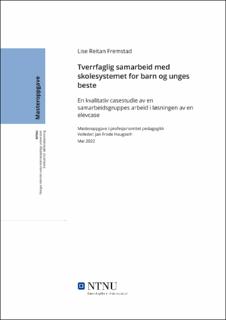| dc.contributor.advisor | Jan Frode Haugseth | |
| dc.contributor.author | Lise Reitan Fremstad | |
| dc.date.accessioned | 2022-08-06T17:19:51Z | |
| dc.date.available | 2022-08-06T17:19:51Z | |
| dc.date.issued | 2022 | |
| dc.identifier | no.ntnu:inspera:112400045:26986613 | |
| dc.identifier.uri | https://hdl.handle.net/11250/3010478 | |
| dc.description.abstract | Denne oppgaven tar for seg tverrfaglig samarbeid i skolesystemet. Jeg har hatt et mål om å se på hvordan skolen samarbeider tverrfaglig med andre hjelpeapparat til barn og unges beste, for å kunne si noe om hvilke sosiale konstruksjoner som er aktive i slike samarbeid. Det har derfor handlet om å indikere faktorer som har fremmet produktivitet til samarbeidet, og hva som har bidratt til at ulike utfordringer har oppstått. Problemstillingen som ligger til grunn for oppgaven er derfor «Hvordan samarbeider skolen tverrfaglig med samarbeidspartnere i løsningen av en case?»
Studien baserer seg på kvalitativ metode. Det er utført en casestudie med intervju, hvor informantene er aktører som jobber sammen om en elevcase. Teamet som intervjues består av skolens rektor, elevens kontaktlærer, elevens fostermor, representant fra Bufetat og barnevern. Som analysen vil vise, har aktørene samarbeidet over en lengre tidsperiode. I løpet av prosessen inntraff en stor endring, som har bidratt til at elevens situasjon har bedret seg betraktelig. Analysen vil vise hvordan de involverte fremstiller samarbeidet tilbake i tid, til betraktninger om hvordan det endret seg til det beste for elevens situasjon. Analysen er derfor delt opp med kategoriene «utfordringer», «forutsetninger og vendepunkt» og «suksessfaktorer».
Resultatene viser utfordringer som lite tillitt mellom samarbeidsaktører, uavklarte relasjonsforhold og ulike oppfatninger av sakskomplekset. Ulike oppfatninger vedrørende gjennomføring av tiltak og ressursbruk for eleven skapte mistillit, samtidig som et ulikt fokus på elevens atferd virket hemmende for relasjonene. I nyere tid ble enkelte samarbeidstiltak belyst som forutsetninger for at casen fikk et vendepunkt. Dette handlet om å innhente ny kunnskap ut ifra behovet, og sikre at den ble felles for alle gjennom en skoleledelse som fulgte opp og tok kunnskapen til etterretning. Når aktørene kunne støtte hverandre på tvers, endret dette samarbeidsklimaet. Funnene viser også en viktighet av at elevsituasjonen blir møtt med positive holdninger av alle ansatte som skal ivareta eleven, ikke bare de som jobber tettest på.
Suksessfaktorer som endret elevens situasjon, innebar hyppigere møter med tydelige rollefordelinger. Arbeid utenfor mandatet ble essensielt som grobunn for tillit, og for at partene kunne løse casen til det beste for eleven. Det kommer også frem at positive holdninger til andre profesjoner, godt skole-hjem samarbeid og høy grad av elevmedvirkning, har vært viktig for at casen kan forstås som en suksesshistorie i dag. Det samme gjelder betydningen av et godt samarbeid mellom hjemmet og skolens eksterne aktører. | |
| dc.description.abstract | This assignment is about interdisciplinary collaboration in school. It has been a goal to look at how the school system collaborates with other support systems to the best for young people and children, and to indicate which social constructions that appears in those kinds of collaborations. This has included looking at different factors that have contributed to productivity to the cooperation, and factors that contributes to a variation of challenges. The thesis question that underlies this assignment has therefore been «how does the school cooperate interdisciplinary with other collaborators in the solution of a case?»
The study is based on a qualitative method. I’ve been doing a case study with interviews, where the informants are collaborators who work together in the solution of the case that this assignment represents. The team consist of the school`s principal, the student`s teacher, the student`s foster mother and representatives from Bufetat and childservices. As the analysis will show, the team has collaborated over a longer period. During the process a major change took place, that contributed to a noticeable better situation for the student. The analysis will show how those involved represent the collaboration back in time, and considerations about how it changed to the better for the student`s situation. The analysis is therefore divided into the categories «challenges», «prerequisites and turning point» and «success factors».
The results show early challenges such as low grade of trust between the participants, unresolved relationships and different perceptions of the case complex. Different perceptions of implementations of measures and use of resources for the student created distrust, and different focus on the student`s behavior seemed inhibitory to the relationships. In recent time, some of the collaboration measures were shown to be prerequisites for the turning point. This was about obtaining new knowledge based on the needs, to ensure that the knowledge became common to everyone through a school management that followed up and took it into account. When the collaborators could support each other, the environment in the collaboration changed. The results also show that it’s important for the student’s situation to be met with positive attitudes by all employees, not only by those who have the greatest responsibility.
The decisive success factors that changed the situation, included more frequent meetings with clear role distributions. In this context it has been worked beyond the mandate, which was essential to create trust, and make it possible for the people involved to solve the case to the better for the student. It’s also shown that a positive attitude towards other professions, good home-school collaboration and a high grade of participation from the student has been important for the case to be called a success. As important has also been the collaboration between the student`s home and the school`s external collaborators. | |
| dc.language | nob | |
| dc.publisher | NTNU | |
| dc.title | Tverrfaglig samarbeid med skolesystemet for barn og unges beste | |
| dc.type | Master thesis | |
